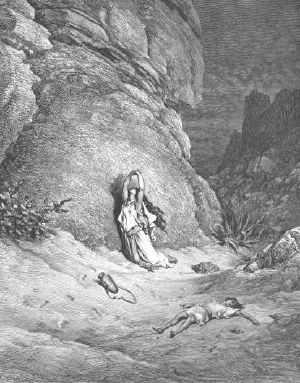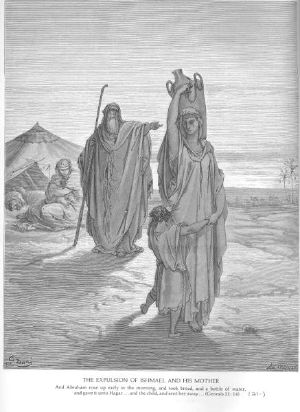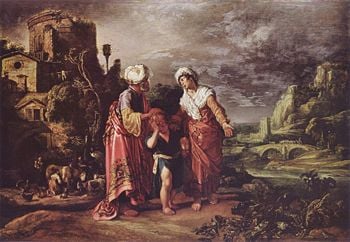Hagar
Hagar (Arabic هاجر; Hajar; Hebrew הָגָר "Stranger") was an Egyptian-born handmaiden of Abraham's wife Sarah in the Bible. She became Abraham's second wife and the mother Ishmael. Her history is narrated in the Book of Genesis.
Because Sarah could not have children she gave Hagar to Abraham as his second wife, or concubine. The two women soon became enemies, and after the birth of Sarah's own son Isaac, Abraham sent Hagar into exile at Sarah's direction because God told him, "whatever Sarah says to you, do as she tells you, for through Isaac shall your descendants benamed." (21:12)
Hagar is the first biblical woman after Eve to whom God spoke directly. In the rabbinical tradition, she is identified as a daughter of Pharaoh. She is a figure a particular importance in the Islamic tradition, both as the mother of Ishmael, with whom she settled near Mecca,and as well as the ancestor of the prophet Muhammed.
Hagar in the Bible
The story of Hagar is found in Genesis 16 and 21, where Hagar is identified as an Egyptian slave belonging to Sarah. Being barren for many years, Sarah gives Hagar to her husband Abraham as a second wife, saying "perhaps I can build a family through her." (16:2) After she becomes pregnant, however, Hagar openly despises Sarah. When her mistress abuses her in retaliation, Hagar flees to the wilderness. There she meets an angel of Yahweh. She is the first biblical woman to encounter such a being. The angel commands her to return and submit to Sarah. He also prophesies that she will give birth to a son named Ismael, who "will live in enmity with all his brothers." Later, however, God declares the Abraham that Sarah herself will bear him a son. God agrees to bless Hagar's son as well, but it will be with Isaac that He will establish a special covenant. (17:20-21)
Sarah miraculously conceives and gives birth to Isaac. When the child is weaned, Sarah observes Ishmael, who is 14 years old, "mocking" him in a way that she finds threatening. She demands that Abraham to expel Hagar and Ishmael. Abraham protests, but God commands him to grant Sarah's demand.
- Listen to whatever Sarah tells you, because it is through Isaac that your offspring will be reckoned. I will make the son of the maidservant into a nation also, because he is your offspring. (21:12-13)
Abraham provides Hagar and Ishmael with bread and water and sends them back into the wilderness.
Wandering in the desert near Beersheba, Hagar soon runs out of water and despairs. She leaves Ishmael nearby and sinks into a depression, saying "I cannot watch the boy die." God, however, hears the boy crying speaks to Hagar: "Lift the boy up and take him by the hand, for I will make him into a great nation."
Suddenly, a spring of fresh water appears. Hagar and Ishmael are rescued. Mother and son settle in the area, and Hagar eventually finds a wife for Ishmael in Egypt. Within two generations, Hagar's progeny have grown to become a trading clan traveling between Egypt and Canaan. It is thus a caravan of Ishmaelites who buy the patriarch Joseph from his scheming brothers and sell him to one of Pharaoh's officials. (37:28)
Hagar's male grandchildren are listed the the Book of Chronicles (1:29-30): Nebaioth, Kedar, Adbeel, Mibsam, 30 Mishma, Dumah, Massa, Hadad, Tema, Jetur, Naphish and Kedemah. Hagar's granddaughter Mahalath married Isaac's son Esau and thus become one of the ancestors of the Edomites, according to biblical tradition (Gen. 28:9).
Critical views
Scholars suspect that the two stories of Hagar in the wilderness may actually be two versions of the same story from different sources. Each follows a similar pattern: Hagar's fertility, Sarah's jealousy, Abraham's affirming Sarah's position, Hagar's exile, and a dramatic rescue by God. In the first version, from the "J" of Yahwist source, Hagar meets the angel of "Yahweh" (the Lord). In the second, from the "E" or Elohist source, it is "Elohim" (God), not Yahweh who speaks to Hagar. For additional information see the article on the documentary hypothesis.
Liberation theology and feminist traditions find identity with Hagar as an example of the silently victimized woman. The conflict between Sarah and Hagar is sometimes used as a classic example of conflicts between women under patriarchal systems.
New Testament
In his letter to the Galatians, Paul equates the Christians with Issac, the offspring of Sarah, while equating the Jews with the the offspring of Hagar. He compares the persecution of Christians by the Jews to the mistreatment of Isaac by his older brother Ishmael, suggesting that Jews do not share in the inheritance of Christians:
- Now you, brothers, like Isaac, are children of promise. At that time the son born in the ordinary way persecuted the son born by the power of the Spirit. It is the same now. But what does the Scripture say? "Get rid of the slave woman and her son, for the slave woman's son will never share in the inheritance with the free woman's son." (Gal. 4:28-29)
In Rabbinical tradition
According to Rabbinical tradition (Midrash Gen. R. 45), Hagar was the daughter of Pharaoh. Was given to Sarah as a gift by her father and returned with Abraham and Sarah to Canaan from Egypt. The rabbis note several good qualities in Hagar. For example, while Samson's father was struck with fear when he saw the angel of God (Judges 13:22), Hagar was not frightened by the approach of this awesome messenger. Her fidelity is also praised even after Abraham sent her away, she kept her marriage vow to him. In one tradition, she is identified with Keturah (Gen. 25:1), the wife that Abraham reportedly took later in life. One tradition explains that after the death of Sarah, Isaac brought Hagar back to Abraham's house, where she lived with him until his death.(Gen. R. 60).
Other rabbinical authorities, however, take a much dimmer view of Hagar's character. In one opinion, Hagar reportedly gossiped viciously about Sarah. (Gen. R. 45). It is further offered that Hagar relapsed into idolatry in the wilderness. Also, the fact that she chose an Egyptian woman as her son's wife is seen as evidence that her belief in the true God was not sincere.(Gen. R. 53) Finally, her son not only mocked Isaac, but sought to kill him. [1] In later Jewish mysticism, Hagar is sometimes identified with the succubus Lilith.
Hagar in Islamic tradition
(Note: out of respect for our Islamic readers, no images will be included in this section.) Hagar is quite important in the Islamic tradition. The hadith of Abu Huraira follows a similar line to the rabbinical tradition that Hagar (Hajar) became Sarah's slave as a gift from the king with whom Sarah stayed temporarily as Abraham's "sister."
- The tyrant then gave Hajar as a girl-servant to Sarah. Sarah came back (to Ibrahim) while he was praying. Ibrahim, gesturing with his hand, asked, "What has happened?" She replied, "Allah has spoiled the evil plot of the infidel and gave me Hajar for service." Abu Huraira then addressed his listeners saying, "That (Hajar) was your mother, O you Arabs, the descendants of Ishmael, Hajar's son." (Sahih Bukhari 4.577-578; Sahih Bukhari 7.21)
Ibrahim, by God's command, accepted Sara's request to send Hajar and Ishmael away. Under the guidance of God, they entered the land of Mecca. The baby was overcome with weakness; it seemed that he was passing the last moments of life. Hajar ran seven times back and forth in the scorching heat between the two hills of Safa and Marwa, trying to spot any water in the area, until, completely disappointed and with tear-filled eyes, she returned to her baby. (The agony of Hagar in her search for water is remembered by Muslims by a ritual of walking (sa`i, Arabic: سَعِي) that signifies her journey between the two hills in their pilgrimage at Mecca.)
God then sent the Angel Gabriel. He struck the ground and from that spot, a clear spring gushed out and began to flow under Ishmael's feet. The spring supposedly still exists today and is called the Zamzam Well.
Little by little, birds came to use the water of the spring. The tribe of Jorhom, who dwelt in the area, discovered the spring because of the birds flying overhead and the tribe then settled beside it. They asked her permission to use the spring and she agreed. From time to time, Ibrahim would go to see Hagar and his child. Visiting them made him happy and reinvigorated him.
In Islamic tradition, it was Hajar's son Ishmael, not Isaac, whom Ibrahim offered to God as a sacrifice. Ishmael is seen as a fully legitimate son of Abraham who inherited equally from his father the legacy of prophethood and the religion of Allah. From Ishmael descended the Prophet Muhammad. The Prophet is traced to Adnan, believed to be a descendant of Ishmael through his son Kedar.
Hagar in contemporary Israel
The story of Hagar's expulsion to the desert has acquired some political connotations in modern Israel, being taken up as a symbol of the expulsion of Palestinians during the 1948 Israeli War of Independence.
It was also the subject of a famous debate on the floor of the Knesset between two female parliamentarians - Shulamit Aloni, founder of Meretz (Civil Rights Movement) and Geulah Cohen of Tehiya (National Awakening Party) - who argued about which interpretation of Hagar's story should be given in Israeli schools.
The Israeli "Women in Black" movement has unofficially renamed Jerusalem's Paris Square as "Hagar Square." The name commemorates the late Hagar Rublev, a prominent Israeli feminist and peace activist.
ReferencesISBN links support NWE through referral fees
- Fischbein, Jessie. Infertility in the Bible: How The Matriarchs Changed Their Fate; How You Can Too. Devora Publishing, 2005. ISBN 978-1932687347
- Frymer-Kensky, Tikva. Reading the Women of the Bible: A New Interpretation of Their Stories. Schocken, 2002. ISBN 978-0805241211
- Murphy, Claire Rudolf. Daughters of the Desert: Stories of remarkable women from Christian, Jewish, and Muslim traditions. SkyLight Paths, 2003. ISBN 1893361721
- Trible, Phyllis, Ed. Hagar, Sarah, And Their Children: Jewish, Christian, And Muslim Perspectives. Westminster John Knox Press, 2006. ISBN 978-0664229825
Credits
New World Encyclopedia writers and editors rewrote and completed the Wikipedia article in accordance with New World Encyclopedia standards. This article abides by terms of the Creative Commons CC-by-sa 3.0 License (CC-by-sa), which may be used and disseminated with proper attribution. Credit is due under the terms of this license that can reference both the New World Encyclopedia contributors and the selfless volunteer contributors of the Wikimedia Foundation. To cite this article click here for a list of acceptable citing formats.The history of earlier contributions by wikipedians is accessible to researchers here:
The history of this article since it was imported to New World Encyclopedia:
Note: Some restrictions may apply to use of individual images which are separately licensed.


